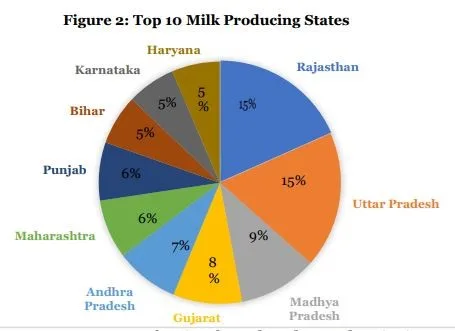Syllabus: GS3/Economy
Context
- Union Home and Cooperation Minister Amit Shah launched the standard operating procedure for ‘White Revolution 2.0’.
About
- Government also launched an action plan on the formation and strengthening of two lakh new Multipurpose Primary Agriculture Cooperative Societies, dairy and fishery cooperatives.
- The White Revolution 2.0 focuses on four key areas – empowering women farmers, enhancing local milk production, strengthening dairy infrastructure and boosting dairy exports.
- White Revolution 2.0 aims to increase milk procurement by dairy cooperative societies by 50 percent over the next five years.
- The dairy cooperatives will procure one thousand lakh litre of milk daily by the end of the fifth year significantly enhancing the livelihoods of rural producers.
- The plan involves setting up and strengthening 100,000 new and existing district cooperative societies, multi-purpose district cooperative societies, and multi-purpose PACS, which will be linked to milk routes with necessary infrastructure.
White Revolution
- The White Revolution in India, also known as Operation Flood, was a significant dairy development program implemented to enhance milk production and address the country’s milk scarcity issues.
- It was launched in 1970 by the National Dairy Development Board (NDDB) under the leadership of Dr. Verghese Kurien, often referred to as the “Father of the White Revolution.”
Key features and Achievements of the White Revolution:
- Cooperative Model: It introduced the cooperative model in the dairy industry, encouraging farmers to form dairy cooperatives.
- Amul: The most prominent outcome of the White Revolution was the success of the Gujarat Cooperative Milk Marketing Federation (GCMMF), which marketed its products under the brand name Amul.
- Increased Milk Production: The program led to a substantial increase in milk production across the country by improving the quality of livestock.
- Infrastructure Development: Infrastructure such as milk processing plants, cold storage facilities, and transportation networks were developed to support the growing dairy industry.
- Economic Impact: It boosted the income of farmers involved in dairy farming, contributing to the overall economic development of rural areas.
- Replication in Other States: The success of Operation Flood in Gujarat led to its replication in other states, further expanding the reach and impact of the White Revolution across India.
Dairy Sector in India
- Production: India is the largest producer of milk in the world, contributing 24% of global milk production in 2021-22.
- The top 5 milk-producing states are: Rajasthan, Uttar Pradesh, Madhya Pradesh, Gujarat and Andhra Pradesh. They together contribute 53.11% of total Milk production in the country.

- Value-Added Products: The dairy sector in India has diversified beyond liquid milk to produce various value-added products such as butter, ghee, cheese, yogurt, and ice cream.
- Economy: The industry contributes 5% to the national economy and directly supports more than 8 crore farmers.
- The sector is an important job provider, especially for women, and plays a leading role in women’s empowerment.
Challenges of Dairy Sector in India
- Low Productivity: The quality of animals is critical in determining its milk productivity and hence overall production.
- Despite being the world’s largest milk producer, India’s productivity per animal is very low, compared with the global average.
- Animal health and breeding services provision: Issues such as diseases, lack of proper breeding practices, and insufficient healthcare facilities affect the overall health and quality of livestock.
- Scarcity of fodder resources: There is a lack of regulations to ensure quality. In the absence of a coherent policy, all kinds of substandard feeds are available in the market.
- Infrastructure Constraints: Inadequate infrastructure such as the lack of a robust cold chain result in spoilage of milk and dairy products, especially in regions with inconsistent power supply.
- Technology Adoption: Lack of awareness, education, and training among farmers impede the implementation of advanced practices such as artificial insemination, efficient feeding methods, and disease management.
- Market Fluctuations and Price Volatility: The lack of stable and remunerative prices for milk affect the income of dairy farmers, making it challenging for them to plan and invest in their operations.
- Quality Standards: Ensuring that products meet both domestic and international quality standards requires investments in quality control measures and adherence to hygiene practices.
Government Initiatives for the Promotion of Dairy Sector
- Rashtriya Gokul Mission: It was launched in 2014, to conserve and develop indigenous cattle breeds.
- Aim: To enhance the productivity and genetic improvement of indigenous cattle.
- National Programme for Dairy Development (NPDD): NPDD has been in place since 2014 and aims to build or strengthen infrastructure for the production of high-quality milk as well as for the procurement, processing, and marketing of milk and milk products through the State Cooperative Dairy Federation.
- Dairy Entrepreneurship Development Scheme (DEDS): DEDS is being implemented by the Department of Animal Husbandry, Dairying, and Fisheries to create self-employment opportunities in the dairy industry.
- It provides financial assistance to individuals for setting up small to medium-scale dairy ventures.
- The National Bank for Agriculture and Rural Development is carrying out the programme.
- National Animal Disease Control Programme (NADCP): It is a flagship scheme launched in 2019 for control of Foot & Mouth Disease and Brucellosis by vaccinating 100% cattle, buffalo, sheep, goat and pig population.
- National Livestock Mission (NLM): The NLM, launched by the Ministry of Agriculture, aims to ensure sustainable development of the livestock sector, including dairy farming.
- It focuses on increasing the productivity of livestock, improving their health, and providing support for fodder and feed resources.
Way Ahead
- Faster vaccination drives to overcome situations like Lumpy skin disease death.
- Robust and effective value chain to overcome the supply chain disruption to maintain the demand for milk and milk products.
- By implementing strategies in a coordinated manner, it’s possible to reduce the cost of milk production in India while improving the livelihoods of dairy farmers and ensuring a sustainable and thriving dairy industry.
Source: TH
Previous article
Food Processing Sector in India
Next article
Modified PM-JI-VAN Yojana